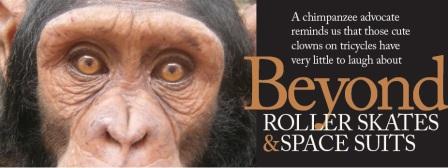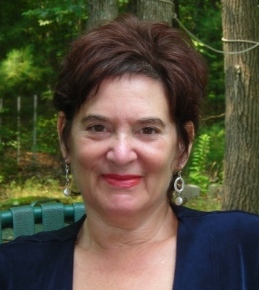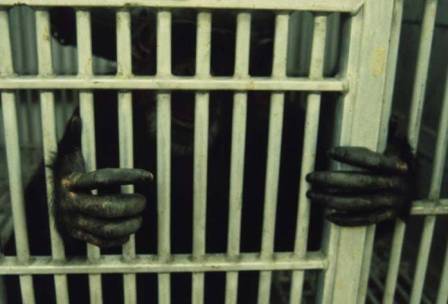

APES ARE NOT native to New Mexico, but they have a long history here nevertheless, thanks to more than a half century as laboratory subjects held at Holloman Air Force Base and the Coulston Foundation, a research facility in Alamogordo. First brought here in the 1950s for space research, chimpanzees have been used by the hundreds for experimentation on disease and toxins, and kept for decades in deplorable conditions, most notoriously at Coulston.
That laboratory went bankrupt in 2000 after years of Animal Welfare Act violations, and hundreds of its chimpanzees were rescued by Save The Chimps and sent to a Florida sanctuary. With 160 chimps still in holding at the Alamogordo Primate Facility at Holloman, and in danger of being subjected to further experimentation, Animal Protection of New Mexico joined other animal welfare groups and Jane Goodall in lobbying for their release in 2010.
A year ago, a landmark decision came when the National Institutes of Health declared it would retire most of its experimental chimpanzees, thanks to advocacy led by APNM and backed by former Gov. Bill Richardson and Sens. Jeff Bingaman and Tom Udall. The decision came after an agency advisory group concluded that almost no research on chimpanzees was really necessary.
Another development came in December with a series of unprecedented lawsuits filed by the Nonhuman Rights Project on behalf of seven privately owned chimpanzees in New York. Head attorney Steven Wise is arguing that the chimps have the status of “legal persons” who can sue for illegal imprisonment. The lawsuits, which are on appeal, have sparked impassioned debate about animal rights and what a legal victory could mean for those species known to have intelligence comparable to humans’: dolphins, orcas, belugas, elephants, Great Apes, and African gray parrots.
With momentum building to outlaw all forms of animal exploitation for profit—whether in sports, scientific research, or the entertainment industry—we thought it a good moment to catch up with local chimpanzee advocate Debra Rosenman of Santa Fe. Rosenman has worked for years to educate the public on the plight of chimpanzees. She founded Project Sweet Dreams to encourage compassion for animals after she was hit with a lifealtering illness in the early 1990s.
In 2000, as she turned a corner on the long process of healing, Rosenman began to have a series of prophetic dreams about chimpanzees, which led her to found Project Sweet Dreams in 2006. She is currently at work on The Chimpanzee Chronicles, a collection of 25 stories from sanctuary directors, primatologists, caregivers, veterinarians, and filmmakers that “will absolutely show the depth of emotion, intelligence, and consciousness that chimpanzees share with us.”

What is it about chimpanzees that you find so compelling? They are incredibly like us—or shall I say, we are so like them. They are highly sensitive, intelligent beings who are emotionally complex, capable of feeling and expressing the same emotions that we do. I’ve always had an interest in them. Many years ago when I had an event planning business in New York, I hired Casey, a 2-year-old baby chimp, for a party. I had no idea then that I was part of the problem! When I learned about their plight, I made a promise to Casey that I would do whatever I could to help. I started Project Sweet Dreams as a way to give back.
Was it your illness that changed your relationship to them? My life completely fell apart after an acute exposure to pesticides collapsed my immune system. I was diagnosed with Multiple Chemical Sensitivity and became allergic to everything in my environment. I gave up my home, my job, the daughter I was about to adopt from Vietnam. I gave away just about all of my material possessions and lived in my car. It was a period of deep grief.
It was during this time that I began to have dreams about chimpanzees. I actually had one dream that changed the course of my life. I was at an artist’s opening at his home in the back woods of Canada. He showed me a gorgeous book of photographs called Animal Expressions. Then he turned around, looked me in the eye, and said, “Be receptive to the beauty, grace, and deep wonder of the forest, the animals, and our own human nature. This is your healing place.”
That dream somehow helped you begin the healing process? It was an initiation. My relationship with spirit, animals, and the earth helped heal me. The animals taught me how to be in my body. We all embody our trauma, which is held deep in our cells, organs, and muscles. The chimpanzees encouraged me to open a dialogue with my body so I could begin to heal. Chimpanzees, like all wild animals, inhabit their bodies with total presence. I believe they helped me bridge the gap between illness and wellness.
So you naturally felt the need to give something back to them. Yes. I started reading everything I could, immersing myself in the language, history, and plight of the chimpanzees. Chimps around the globe are in great peril from deforestation, the bushmeat trade, and poaching, and suffer greatly as subjects in biomedical research, actors, and pets. A century ago, there were 2 million chimpanzees living in the wild; today there are less than 250,000. They are regularly wiped out by poachers, who kill the adults and steal their babies.
The United States is the only country in the world that continues to store chimpanzees for experimental testing. Many have lived alone most of their lives in tiny steel cages, 5 x 5 x 7 feet, with no companionship, sunlight, or enrichment.
Is this what you teach in your classroom presentations? I teach children about the history of chimpanzees, what it means for them to be a true sibling species, sharing 98 percent identical DNA with us. It’s not in a chimp’s nature to put on roller skates. In order to keep them in line, they’re beaten, sometimes as infants. Pet chimpanzees start out adorable as infants, but as adults their strength is seven times that of a man. We raise them as humans and expect them to act like humans, but they’re wild animals. They often end up abandoned or sold to research labs or trainers in the entertainment industry.
Did you ever consider building your own sanctuary, or getting involved in rescue? I would actually love to be around chimpanzees. For now, the message in my book is a way of helping them. My goal is to open hearts as people read. It’s important for me to give voice to hope, compassion, and the possibilities for change. Who knows, maybe a biomedical researcher will read the stories, have a heart opening, and change course. Miracles happen!
